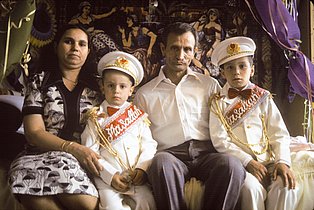
The recruitment agreement between Germany and Turkey, which was concluded on October 30, 1961, was an incisive event in the economic, but above all in the social development of the Federal Republic of Germany. It was not the first, preceded by similar agreements with Italy (1955), Spain and Greece (1960) and followed by others with Morocco (1963), Portugal (1964), Tunisia (1965) and Yugoslavia (1968). But the recruitment agreement with Turkey was certainly the most important, because it brought by far the largest number of people to the Federal Republic, and people of Turkish origin are still the largest migrant group in Germany today. The recruitment agreements were primarily for economic reasons. They were a response to Germany's need for labor during the economic miracle of the 1950s - with far-reaching consequences. Many of the so-called guest workers did not return to their home countries, but remained in Germany and increasingly turned the country into an immigration society.
The exhibition with photographs by Henning Christoph showed the period from the end of the 1970s to the end of the 1980s, i.e. the phase in which many of the former Turkish "guest workers" decided to stay in Germany, bring their family members with them or start a family and find a new home here.
The German-American photographer Henning Christoph, born in Grimma near Leipzig in 1944 and winner of several World Press Photo awards, photographed the everyday life of Turkish migrant workers in Germany from 1977 to 1989, focusing on the Ruhr region. In the exhibition, the photographer himself spoke in a video interview and reported on the creation of his long-term documentation of the lives of people of Turkish origin in Germany. From 1977, commissioned by GEO magazine, he was able to spend a year and a half intensively researching and photographing. Under the title "The German Turks," the pictures appeared in 1979 in the first comprehensive photo reportage on this subject. The legendary GEO reportage was shown in its entirety in the exhibition.
The special exhibition at the Ruhr Museum presented in more than 150 photographs in black and white and color a documentation that testifies to the photographer's friendships, his exploration of everyday Turkish life and creative sovereignty. The images show the families at work, at school, at circumcision and wedding ceremonies, at political and religious events, shopping, shechitaing, processing sheep's wool, cooking, traveling to Turkey, and visiting the oil ring. An overall picture emerges of different groups of families from Turkey who - often following their personal desire to improve their living conditions - chose to migrate to Germany for work.
A film from zeitlupe.tv
During the duration of the exhibition, an extensive and participatory cultural program will take place. It includes, among other things, discussion evenings with the photographer of the exhibition Henning Christoph, photography lectures, a storytelling café, a writing workshop, film evenings, a reading, cooking classes, excursions and a reading day.
The complete program of events can be downloaded here:
The catalog edited by Heinrich Theodor Grütter and Stefanie Grebe "Mustafas Traum. Photographs by Henning Christoph on Turkish Life in Germany 1977-1989" presents more than 150 black-and-white and color photographs that depict the photographer's friendships as well as his participation in everyday Turkish life and testify to his creative sovereignty. Photographer Henning Christoph, a multiple World Press Photo award winner, photographed the lives of migrant workers in Germany from 1977 to 1989, focusing on the Ruhr region. With the pictures of everyday life, a current conversation with Henning Christoph and a reprint of the legendary GEO reportage "The German Turks" (1979), this catalog is the photographer's first monograph on the subject of Turkish migration.
The 240-page catalog costs €24.95 and is published by Klartext Verlag. ISBN number 978-3-8375-2482-1.
These teaching materials support the preparation and deepening of the exhibition visit in terms of a sustainable educational experience by showing different ways of approaching the topics of "migration" in general and "Turkish labor migration since the 1960s" and "Turkish-German life" in particular. The collection is aimed at teachers who teach students from grade 9 and can be used in the subjects German, history, politics and social studies. The materials can be used independently of each other and in any order. Care has been taken to take into account different levels of education as well as individual talents, inclinations and interests. The suitability and assignment to a subject, grade level and type of school is up to the teacher's assessment. The individual sheets are designed in such a way that they can be used as a direct copy template.
Teaching materials for preparation
Further information on the exhibition and the extensive accompanying program can be found here as PDFs for download:
The exhibition project has its own Instagram channel. Even more info, stories and also other perspectives can be found here:
Share